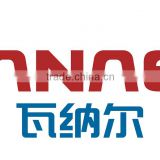Small bell rain gutter chain
USD $15 - $36 /Meter
Min.Order:10 Meters
Quick Details View All >
Guangzhou Wanael Building Material Co., Ltd.
Product Details
rain gutter chain
These rain cups are made of pure copper and are reinforced with a folded lip along the top. Each cup is welded together by hand.
Antique color: Aging effect is not a chemical coating or paint.it is done by high technology and never fade. This rain chain looks a hundred years old right out of the box!
Why would I choose a Half Round Gutter System?
Half-round gutters were the traditional gutter style on homes built before 1950 and remain a popular choice on historic renovation projects, traditional renovations, and new upscale custom housing.
The simple lines of half-round gutters compliment heavily textured materials such as slate, shakes, and tiles. Where crown moldings exist in lieu of fascias, half-round gutters can be easily hung from the roof. Where fascia exist, fascia brackets may also be used.
What are the advantages and disadvantages of Half Round Gutters?
Advantages: Appropriate for both historic restoration and new construction, both contemporary and traditional. Attractive and durable.
Disadvantages: Higher initial material and labor cost than some other gutter products. Not generally used on non-custom housing.
What is the role of solder in a copper system?
In roof and wall systems where water-tight seams are required, soldering is specified. A soldered seam will join two pieces of copper or steel into a cohesive, watertight unit that will expand and contract as one piece. Well soldered seams are, in many cases, stronger than the original base material and will provide many years of satisfactory service.
What is (Copper) Patina?
Typically allowed to weather naturally, copper develops a blue-green coloration resulting from the formation of a protective copper oxide patina. During the initial weeks of exposure, particularly in a humid atmosphere or in areas of frequent rainfall, radical color changes often take place with iridescent pinks, oranges and reds interspersed with brassy yellows, blues, greens and purples. During continued exposure, these interference colors fade and are replaced by relatively uniform russet brown shades referred to as statuary or oxidized finishes. In industrial and nautical atmospheres, the natural patina generally forms in approximately five to seven years. In rural atmospheres, where the quantity of air-born sulfur dioxide is relatively low, patina formation may not reach a dominant stage for 10 to 14 years. In arid environments, the basic sulfate patina may never form due to the lack of sufficient moisture. Similarly, exposed horizontal surfaces develop the patina more rapidly than sloping surfaces which, in turn, patinate more rapidly than vertical surfaces. The critical variable, in all instances, is the dwell time of moisture on the exposed surfaces.
The progressive oxide, sulfide and sulfate films which develop on copper exposed to the atmosphere are quite thin, two to three thousandths of an inch and highly adherent, but with relatively low abrasion resistance. Neither the oxide nor sulfide films are particularly corrosion resistant. The sulfate patina, on the other hand, is highly resistant to all forms of atmospheric corrosion, once it has had an opportunity to form completely. It thus significantly increases the durability and, hence, the service life of copper roofing and flashing.
What are the advantages and disadvantages of the various metals you offer for your Gutter Systems?
Aluminum
Advantage: Low cost, and relatively easily maintained. Available in 20 colors. Easily installed. Limited 20 year warranty on baked on enamel coating.
Disadvantage: Expands twice as much as steel and 50 percent more than copper. Less strong than steel or copper. Can be dented (especially in lighter thickness such as .027) more easily than other gutter materials.
Copper
Advantage: Considered a quality, premium product. An appropriate material for historic preservation projects. Copper patina (See Copper Patina below) blends well with many roofing products. Low maintenance, does not require paint. Will not rust and is well suited for nautical environments. The most durable and longest lasting material currently available for gutters.
Disadvantage: More costly than alternative materials. Requires skilled installers for cutting and soldering of joints and transitions.
How are gutters sized?
Gutters are often sized according to the roof area they drain.
· 5" K-style gutters are the residential industry's standard.
· 6" K-style gutters are used for larger roofs.
· Half Round gutters are typically sized 1 inch wider than K-style to provide the equivalent capacity.
Wider gutters may be required for certain hard surface roofing materials, such as slate and tile, or used on steeply-pitched roofs, to prevent water from shooting over the gutter. Gutters should be positioned tight against roofing materials and the fascia.
How do you determine the size of Downspout to use?
Downspout diameters are sized according to the roof area they drain. A rule of thumb used in the industry is that a 2x3 inch downspout will suffice for a 600 sq. ft. of roof, a 3x4 inch downspout for 1,200 sq. ft. of roof, and 4x5 inch downspout for 2000 sq. ft. of roof. The typical downspout size for a 5” K-style gutter is 2x3 inches, but 3x4 inches is preferable because it is less likely to become clogged and is easier to clean out.
What is the purpose of gutter and downspout systems?
The purpose of gutter and downspout systems is to collect rainwater from the roof and direct it away from the building foundation by means of downspout extensions, splash blocks, or underground drain lines.
Contact Supplier

You May Like

New Products
Find Similar Products By Category